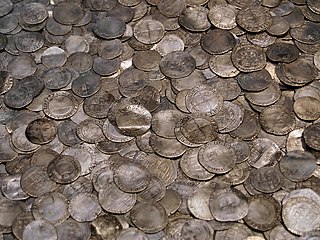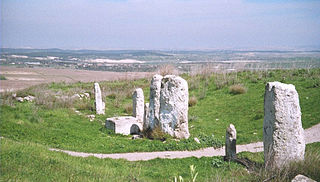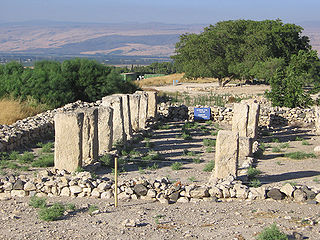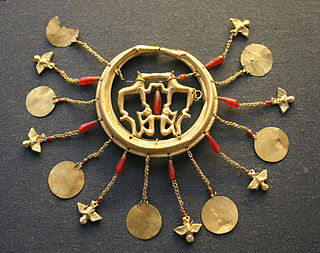Related Research Articles

Tel Abel Beth Maacah is a large archaeological tell with a small upper northern section and a large lower southern one, connected by a saddle. It is located on the northern border of present-day Israel, about 2 km south of the town of Metula and about 6.5 km west of Tel Dan.

Tel Megiddo is the site of the ancient city of Megiddo, the remains of which form a tell, situated in northern Israel near Kibbutz Megiddo, about 30 kilometres (19 mi) south-east of Haifa, at the western edge of Jezreel Valley. Megiddo is known for its historical, geographical, and theological importance, especially under its Greek name Armageddon. During the Bronze Age, Megiddo was an important Canaanite city-state and during the Iron Age, a royal city in the Kingdom of Israel.

A hoard or "wealth deposit" is an archaeological term for a collection of valuable objects or artifacts, sometimes purposely buried in the ground, in which case it is sometimes also known as a cache. This would usually be with the intention of later recovery by the hoarder; hoarders sometimes died or were unable to return for other reasons before retrieving the hoard, and these surviving hoards might then be uncovered much later by metal detector hobbyists, members of the public, and archaeologists.

The archaeology of Israel is the study of the archaeology of the present-day Israel, stretching from prehistory through three millennia of documented history. The ancient Land of Israel was a geographical bridge between the political and cultural centers of Mesopotamia and Egypt.

The Jezreel Valley, or Marj Ibn Amir, also known as the Valley of Megiddo, is a large fertile plain and inland valley in the Northern District of Israel. It is bordered to the north by the highlands of the Lower Galilee region, to the south by the Samarian highlands, to the west and northwest by the Mount Carmel range, and to the east by the Jordan Valley, with Mount Gilboa marking its southern extent. The largest settlement in the valley is the city of Afula, which lies near its center.

Gezer, or Tel Gezer, in Arabic: تل الجزر – Tell Jezar or Tell el-Jezari is an archaeological site in the foothills of the Judaean Mountains at the border of the Shfela region roughly midway between Jerusalem and Tel Aviv. It is now an Israeli national park. In the Hebrew Bible, Gezer is associated with Joshua and Solomon.

Tel Hazor, also Chatsôr, translated in LXX as Hasōr, named in Arabic Tell Waqqas / Tell Qedah el-Gul, is an archaeological tell at the site of ancient Hazor, located in Israel, Upper Galilee, north of the Sea of Galilee, in the northern Korazim Plateau. Both as a Middle Bronze Age Canaanite city and as an Israelite one, Hazor was the largest fortified city in the country and one of the most important in the Fertile Crescent. It maintained commercial ties with Babylon and Syria, and imported large quantities of tin for the bronze industry. In the Book of Joshua, Hazor is described as "the head of all those kingdoms". Though some scholars do not consider the Book of Joshua to be historically accurate, archaeological excavations have emphasized its importance.

The Canaanite religion was the group of ancient Semitic religions practiced by the Canaanites living in the ancient Levant from at least the early Bronze Age to the first centuries AD. Canaanite religion was polytheistic and, in some cases, monolatristic.


The Pereshchepina Treasure is a major deposit of Bulgar and Khazar objects from the Migration Period.

Dor is a moshav in northern Israel. Located near Zikhron Ya'akov, it falls under the jurisdiction of Hof HaCarmel Regional Council. In 2021 it had a population of 451. It was named after the ancient Phoenician city of Dor, which was inhabited by the tribe of Manasseh in the Israelite period.

Menhet, Menwi and Merti, also spelled Manhata, Manuwai and Maruta, were three minor foreign-born wives of Pharaoh Thutmose III of the Eighteenth Dynasty. They are known for their lavishly furnished rock-cut tomb in Wady Gabbanat el-Qurud near Luxor, Egypt. They are suggested to be Syrian, as the names all fit into Canaanite name forms, although their ultimate origin is unknown. A West Semitic origin is likely, but both West Semitic and Hurrian derivations have been suggested for Menwi. Each of the wives bear the title of "king's wife", and were likely only minor members of the royal harem. It is not known if the women were related as the faces on the lids of their canopic jars are all different.
Tel Motza or Tel Moẓa is an archaeological site in Motza, on the outskirts of Jerusalem. It includes the remains of a large Neolithic settlement dated to around 8600–8200 BCE, and Iron Age Israelite settlement dating to around 1000 to 500 BCE and identified with the biblical Mozah mentioned in the Book of Joshua. In 2012, Israeli archaeologists announced the discovery of a temple from the Iron Age IIA levels at Motza, contemporary with the First Temple in Jerusalem.

The Aegina Treasure or Aigina Treasure is an important Minoan gold hoard said to have been found on the island of Aegina, Greece. Since 1892, it has been part of the British Museum's collection. It is one of the most important groups of Minoan jewellery.

The Tell el-Ajjul gold hoards are a collection of three hoards of Bronze Age gold jewellery found at the Canaanite site of Tell el-Ajjul in Gaza. Excavated by the British archaeologist Flinders Petrie in the 1930s, the collection is now mostly preserved at the British Museum in London and the Rockefeller Museum in Jerusalem. The treasure ranks amongst the greatest Bronze Age finds in the Levant.

Tell Keisan, تل كيسان or Tel Kisson, תל כיסון, is an archaeological site located 8 km (5.0 mi) from the Mediterranean coast in the Galilee region of Israel between Haifa and Akko. The tell is approximately 15 acres in size and is composed of the accumulated ruins of many large cities dating back to the Chalcolithic period.
Matthew J. Adams is an archaeologist who specializes in the Near East. He earned his degrees at Pennsylvania State University and the University of California, Los Angeles. He served as the director of the Albright Institute of Archaeological Research in Jerusalem (2014–2022), and is the current the president of American Archaeology Abroad, Inc. He has worked on several archaeological projects in the past, and is currently director of the Jezreel Valley Regional Project, Co-Director of the Megiddo Expedition along with Israel Finkelstein and Mario Martin, and co-director of the Solomon's Pools Archaeological Project with Mark Letteney.

The Cisjordan corpus of Phoenician Iron Age hacksilber (hacksilver), dated between 1200 and 586 BC, is the largest identified collection of pre-coinage silver in the ancient Near East. The corpus was identified by Christine Marie Thompson in 2003. The corpus is composed of 34 silver hoards found at 15 sites in ancient southern Phoenicia or modern Israel and Israeli-occupied territories, this area is termed "Cisjordan". Significant hoards have been found at Tel Dor, Eshtemoa, Tell Keisan, Ein Hofez, and Akko. The other hoards were found at Megiddo, Bet Shean, Shechem, Shiloh, Gezer, Tel Miqne-Ekron, Ashkelon, Ajjul, Ein Gedi, and Arad.
This page lists major events of 2019 in archaeology.

'En Esur, also En Esur or Ein Asawir, is an ancient site located on the northern Sharon Plain, at the entrance of the Wadi Ara pass leading from the Coastal Plain further inland. The site includes an archaeological mound (tell), called Tel Esur or Tell el-Asawir, another unnamed mound, and two springs, one of which gives the site its name.
References
- ↑ "Unique Gold Earring Found in Intriguing Collection of Ancient Jewelry at Tel Megiddo". Global Scientia. 2012-05-23. Retrieved 2012-05-28.
- ↑ "Gold Egyptian Earring Found in Israel". LiveScience. 2012-05-21. Retrieved 2012-05-28.
- ↑ Hasson, Nir (2012-05-22). "Megiddo dig unearths cache of buried Canaanite treasure - Haaretz Daily Newspaper | Israel News". Haaretz.com. Retrieved 2012-05-28.
- 1 2 3 4 5 6 7 "Ancient Canaanite Gold and Silver Jewelry Hoard Reveals Past Secrets". Decoded Science. 2012-06-05. Retrieved 2012-07-05.
- ↑ Daniela Berretta. "Trove of 3,000-year-old jewelry found in Israel". Philly.com. Associated Press. Retrieved 2012-05-28.